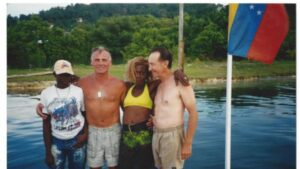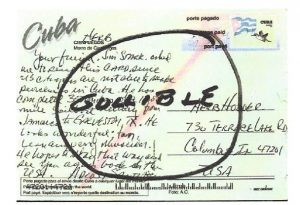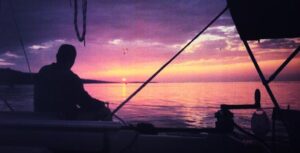Captain Bob Cook of Offshore Sailing, discovered on the internet, offered the experience I was looking for. Not only did Cook deliver sailboats around the world, but he offered a comprehensive course to crew members in offshore sailing–for which he charged a fee.
Just a smattering of the instruction he offered included: trip planning, provisioning, vessel management, navigation, tides, weather, heavy weather sailing, anchoring, and mooring, watch procedures, and foreign port requirements.
I flew out of Indianapolis and joined the boat in Jamaica. The 50-foot sloop, Painkiller, had originally been sailed out of Tortola in the BVI with crew One, but now we took over in Port Antonio, Jamaica, as Crew Two.

There would be four of us; Captain Bob, me, Kevin Berry–a rather inexperienced sailor from Massachusetts, and Mark Sizemore, who had actually been a member of crew one. Mark was a quiet insouciant individual, who simply stated, just didn’t give a hoot about anything. Capt. Bob was a skillful sailor, with a lot of good experience to learn from. But the Capt. was egotistical, unfriendly, and unlikeable. So, this was the crew I would be spending nearly three weeks with in very confined space. Good luck, I mused.
Our route out of Jamaca would be north to Cuba, before spending several days sailing 700 miles across the Gulf to Texas. In Houston, the boat would be put on a truck and delivered to its new owner in California. Our enroute Cuba destinations would only involve anchoring in several bays along its southern coast. There would be only two stops that included going ashore.

At our first anchorage, a mile offshore of Cayo Cruz, we were greeted by the military who motored out in an outboard. The officer in charge informed us that we were not welcome and must leave immediately. We protested, arguing that we had no intention of going ashore, only wished to spend the night safely anchored along the reef-lined coastline. The soldier finally accepted our plea but demanded we leave at dawn the next morning. We agreed.
Several minutes later, another visitor arrived by swimming with a snorkel. He had a plastic garbage bag tied to his waist. Mark spoke Spanish and as our interpreter introduced us to Pedro. In Pedro’s bag were four large lobsters and an assortment of potatoes and ears of corn all of which he was happy to sell us for $10 US dollars. What a wonderful meal that would be.
We no sooner started preparing the diner than another snorkel was seen approaching our boat. It was another swimmer offering peces del mar. Having all we could eat that evening we politely turned down the offer but rewarded the swimmer’s efforts by gifting him with a ball cap with a NIKE swish which he recognized and was very pleased to receive.
Within minutes another snorkel was seen poking above the surrounding water. Yep, another vendor with a bag of wares. This was becoming an international trade fair. He was bought off with red “Go Hoosiers” tee shirt. Our visitor did not understand “Hoosier” until we mentioned Bobby Knight. Knight was known in Cuba for an incident in 1979 during the Pan America Games when Knight was accused of striking a Cuban policeman. The swimmer was beaming when he leaned the connection.
Departing Cayo Cruz at dawn the next morning, we made three other nightly stops at anchorages before approaching Cienfugos. Cienfugos is Cuba’s third largest city with a population of 150,000. It’s marina was several miles inland from the coast, connected to the sea by a miles long waterway. We arrived after sunset, and here Captain Bob demonstrated his expert skills by using established compass headings from one lighted channel buoy to another. It was an instrument approach of the finest execution. Very impressive!
The next day we were free to go ashore for the first time in five days. The only important task that day would be replenishing and restocking our provisions.
Mark and Kevin were intent on hitting the clubs and checking out the local Chicas (young ladies). Bob had sightseeing in mind. I, after several days of togetherness, was just looking for an opportunity to be alone. I volunteered to do the shopping which all readily accepted.

Kevin and Mark and their new best friends
Once on shore I found an English-speaking Cuban who could direct me to a money exchange to trade dollars for pesos and directions to a grocery. He also suggested a friend who spoke some English and had a car to take me on my errands.
Miguel, my driver, was a nice-looking young man, well dressed, about 35-years-old, I guessed. Most of our communication was by sign language, but the first priority to visit a money exchange was clearly understood.
When we arrived at a bank-like structure a mob surrounding the building was huge. Oh no, I thought. This would take all day.
“No, no.” signed Miguel, and ushered me right to the counter. I learned that the Cuban government, in an effort to attract US tourists had established dollar stores where only US currency could be used. The stores had top quality wares and Cuban citizens were desirous of acquiring dollars to shop in those stores. The mob at the money exchange were locals wanting to trade their pesos for dollars.
I assumed I would be shopping in a Cuban grocery and exchanged $200 US dollars for 3,365 pesos. I could hardly get that huge pile of money into my pockets.
The grocery Miguel took me to was large with shelves overflowing with attractive foods. While I shopped one section, I would act out food–plucking an apple off a tree–and send Miguel searching other areas. At last, with our cart filled with goodies, I wheeled up to the cashier. “One hundred and ten US dollars please.” Oh no, this is a dollar store. Miguel slapped his head with embarrassment at the mistake.
Fortunately, I still had enough US cash to complete the purchase, but now I had to go back to the money exchange to redeem my dollars.
Uh oh! No can do! The money exchange only worked in one direction: dollars for pesos, not pesos for dollars. I now had a 3,265-peso souvenir.
On the way back to the boat, I had Miguel stop at a store where I bought 27 postcards to send to friends. At least they took a small portion of my pesos.
Although Cuba welcomes US tourist, the US government prohibits spending money in Cuba. So how could I send postcards obviously purchased in Cuba? Ah ha! I would pretend I was a Cuban by the name of Satiago (James in Spanish) and report having met Jim Stark in Cuba. The cards said: “I have just met your friend Jim Stark and he asked me to write to you. He looks tan, muscular, and very handsome.” Then added a brief note. The 27 cards took over two hours to write.
Relaxing on deck that afternoon, I heard a familiar voice, “Mi amigo, mi amigo!” It was my friend Miguel. He had returned to the dock with his wife. Greeting them both I was able to give them a beer and a quick tour of our boat. Seeing my written postcards, Miguel drove me to a post office where we sent them on their way to friends in the US.
Post Script to the post card story. They were mailed May 8th and arrived May 23rd. One of the recipients was my good friend Herb Hoover. Months later I saw Herb and he said he had received a strange card from some guy name Santiago. I said, “Oh Herb, you’re kidding right? Didn’t you figure out that I had written that card.” Herb still had that card and he sent it to me with a big slash across the text and the word “Gullible” written.

Days later, we left Cuba and started our weeks-long voyage across 700 miles of the Gulf of Mexico. During the night two us us would stand four-hour watches, keeping clear of ships sailing out of New Orleans, Galveston, and other coastal cities. Designated direct routes across the Gulf had been established called fairways, much like airway routes for airplanes. However, private yachts were not allowed in the fairways except to cross them. Being direct routes, we would sail on the fairway’s edge keeping a close watch for transiting merchant ships.
Mark and Keven stood watches together, and the captain and I were teamed. I was surprised how easily I found it to sleep for four hours, then awake fully alert for my watch.
The trick to avoid collision with approaching merchant ships was to take a bearing on the target. If the bearing changed every few minutes, you knew you would miss. However, a constant bearing meant you were on a collision course and required a course change. The latter half of our Gulf passage not only included other ships to avoid but also hundreds of stationary oil rigs. Alertness was mandatory.
We were within 100 miles of Galveston when I came to the cockpit to relieve Mark and Kevin. To my shock I discovered Mark had already gone below to sleep and Kevin was dozing in the cockpit. How long had our boat sailed unprotected was unknown. I shook Kevin roughly awake, shouting, “Are you trying to kill us!”

The captain was below working on his radio and computer and not aware of the unforgivable situation in the cockpit. I didn’t tell him … but probably should have.
Kevin and Mark had become increasingly critical of Capt. Bob. Although I had no problem adjusting to the short sleep cycle, I assumed Kevin and Mark were more and more irritated because of sleep deprivation.
Approaching Galveston Bay, we expected we would need to dock and report to the Customs office to clear into the US. We were totally surprised and pleased to discover the captain was able to do that on his cell phone and we could continue up the inland waterway to Houston. We still had the Immigration folks to deal with and the captain continued to call on his phone to satisfy their requirements.
An hour past Galveston, we were shocked to learn Immigration required us to return to Galveston and to show Immigration our passports. That was the straw that broke the backs of Kevin and Mark. They went ballistic.
We had no choice according to the captain and did an about face back toward Galveston, adding two hours to our transit to Houston. The visit to the Immigration office to stamp our passports took three minutes.
When we returned to the boat and prepared to untie our dock lines, Kenin appeared in the cockpit carrying his bag. “I’m done with this bullshit trip,” he announced. Just behind him was Mark, also packed and ready to leave.
I can’t remember the captain’s words at this moment, but it was something like “goodbye and good riddance.”
Saying goodbye to my shipmates was a solemn parting. Kevin, although rather immature, wasn’t really a bad guy. He just had no business being there. Mark, my mousey crew member really blew me away when he said I was the kind of person he hoped one day to become. Really! Holy cow!
The captain’s only comment regarding K and M, now that we were alone on our transit up the “ditch” to Houston, was “tells you about their character, doesn’t it.”
Thinking perhaps the captain might acknowledge my loyalty to our mission, he destroyed that notion when he said, “So, your workload has just been tripled. You’ll need to clean all four heads, empty food from the refrigerator and freezer, scrub down the deck, and dispose of all trash.” Yes, sir.
I got a flight out of Houston back to Indiana. So, what is my final evaluation. I feel my offshore sailboat delivery was a good experience. The mysteries of long-distance cruising, weather avoidance, foreign port procedures, communications, navigation, customs, immigration procedures, and provisioning had been revealed to me. I could do that now. There would still be tons of things to learn, but now I have the confidence to do it myself should I ever choose to do so.
Captain Bob was an excellent mentor for disciplined seamanship. My days aboard Painkiller will long be remembered.
Mr. Stark,
You are a fascinating individual !
Very much enjoy reading about your adventures.